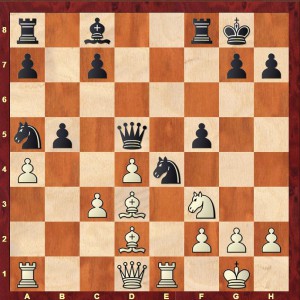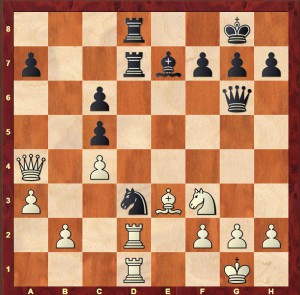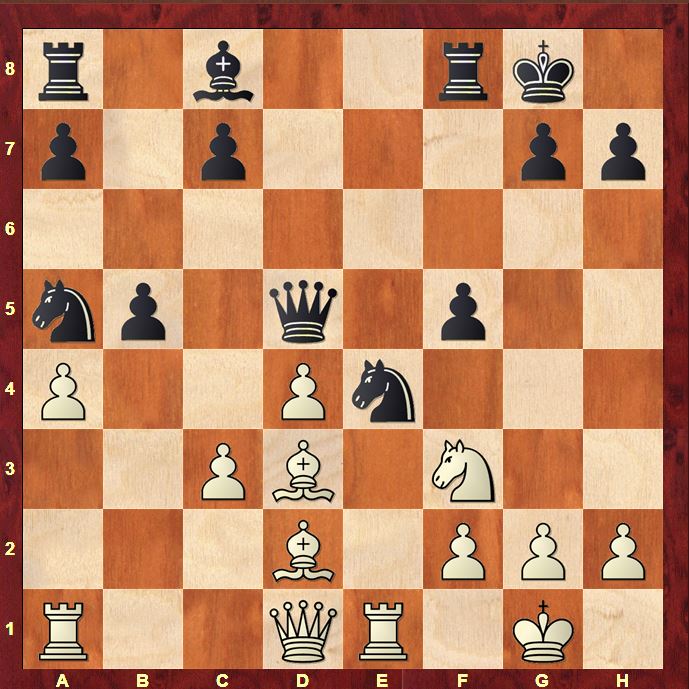It never ceases to amaze me how many complicated games Alekhine played in his career. While browsing through collections of his games, I’m constantly coming across positions where my first instinct is “That can’t possibly work… can it?” In this post we take a look at a couple of Alekhine tactical tidbits that I analysed while delayed in the train to work. Yes, it’s true: the worse the Dutch railways get, the more my chess improves!
The first position is frankly astonishing. It arose in Nyholm-Alekhine Nordic Congress 1912:

Nyholm,Gustaf – Alekhine,Alexander
Nordic Congress 1912
14… Nb3
An absolutely lunatic move! I find it hard to believe that Black is not losing heavy material in the ensuing sequence. I spent most of the journey searching fruitlessly for a clear win!
15.Ra3 bxa4 16.Rxa4 Nbxd2 17.Nxd2 Nxc3 18.Qc2
18…Qd7
A fantastic last-gasp tactic!
18…Nxa4 19.Bc4
19.Ra5 Qxd4
19…Nd5 20.Rxd5; 19…Ne4 20.Nxe4 fxe4 21.Bxe4 Rb8 22.Bxh7+ Kh8 23.Rh5
20.Rc1 Rd8 21.Qb3+ Be6
An amazing resource! If Alekhine saw this early, then it’s astounding!
21…Kh8 22.Rxc3
21…Nd5 22.Nf3 22…Qb4 23.Rxd5 Qxb3 24.Rxd8+ Kf7 25.Bc4+
22.Qxe6+ Kh8
White cannot save both his pieces on the d-file
23.Re5
23.Nb1 Qxd3 24.Nxc3 Qxc3
23.Nf3 Qxd3 24.Re1 Ne4 25.Qxf5 (25.Ne5 Ng5 26.Qe7 Qc3 holds very nicely) 25…Nf6 is about OK for Black despite White’s following trick 26.Re8+ Ng8 27.Rxd8 Qxd8 28.g3
23…Qxd3 24.Rce1 h6 25.Qg6
A blunder. I guess White was exhausted after the previous struggle!
25…Qxd2
0–1
So where did White go wrong? There seem to be a few improvements, but nothing absolutely decisive! In essence, White should be trying to simply regain material and leave himself with a clear positional advantage: the knight on c3 just cannot be trapped!
a)18.Qa1 Qd7 19.Rxa7 (19.Ra5 was my first thought at an improvement, with the beautiful idea of 19…Qxd4 20.Rd5 (20.Bc4+ Kh8 21.Rd5 Ne2+) However, after 20…Qb4 Black is doing reasonably) 19…Rxa7 20.Qxa7
is very pleasant for White as the Nd2 is coming to e5, c7 is weak and the Black light-squared bishop is difficult to develop effectively.]
b) 18.Qc2 Qd7 19.Ra3 Nd5 20.Qc5
is the engine choice with an advantage of +2! That’s a pretty amazing assessment though I agree White is much better. 20…Nb6 21.Bb5 Qd6 22.Bc6 Rb8 23.Rxa7.
c) 18.Qc2 Qd7 19.Ra5 Qxd4 20.Ree5 was not one of my finds: Komodo suggested it while I was checking my analysis at home. With this move, White blocks the path of the Black queen back to the kingside and prepares to round up the knight with Ra/Rec5!
i) 20…Ne4 21.Nxe4 fxe4 22.Bxe4 Rb8 23.Bxh7+ Kh8 24.Bd3;
ii) 20…Rd8 21.Nf3 Qxd3 (21…Qb4 22.Rac5 Ne4 23.Bxe4 fxe4 24.Rxe4 with Ng5 to follow is surprisingly dangerous) 22.Re8+ Rxe8 (22…Kf7 23.Ne5+) 23.Qxd3 is the way to do it!;
iii) 20…c6 21.Nf3 Qb4 22.Rac5 Nd5 23.Rxc6 Nb6
is Stockfish’s counter-suggestion which leaves the situation still murky though White obviously has the initiative.
Amazing!
The second position is a slight correction of Alekhine’s analysis of his exhibition game against Molina in Argentina 1926

Alekhine,Alexander – Molina,Raul
Buenos Aires 1926
In this position, Alekhine played the subtle 24.h3 tempting Molina into 24…Nxb2 when Alekhine had prepared the counterblow 25.Qxa7!!
Undoubtedly shocked, Molina replied
25…Rxa7
and lost after the gorgeous
26.Rxd8+ Bf8 27.Bxc5 h6 28.Rxf8+ Kh7 29.Rdd8 Qb1+ 30.Kh2 Rb7 31.Nh4
Aaah!
31…g6
31…g5 32.Rh8+ Kg7 33.Rdg8+ Kf6 34.Rxh6+ wins
32.Bd4 f6 33.Bxf6
1–0
While reading, I got interested in 25…Nxd1 which I couldn’t refute:
26.Rxd7 Nxe3
The best move order. 26…Rxd7 27.Qxd7 Nxe3 28.Qe8+ Bf8 29.fxe3 is surprisingly awkward. White threatens Ne5–d7 as well as the advance of the a-pawn (29.Qxe3 Qb1+ 30.Kh2 Qc2 31.Nd2 g6 is fine for Black. White is too tied up to be able to organise the advance of the a-pawn)
27.fxe3
27.Rxd8+ Bxd8 28.fxe3 Qe4 29.Qxc5 Qb1+ is equal. By forcing the queen to c5, Black can now meet Kh2 with …Bc7+ 30.Kf2 Qc2+ 31.Kg1 Qb1+
27…Rxd7 28.Qxd7 Qb1+
28…Bf8 was given by Alekhine, but the text is considerably stronger: in fact it changes the evaluation of the whole combination.
29.Kh2 Qb8+
The key point: White’s king will not escape the checks easily.
30.Kh1 Qb1+ 31.Ng1
is the only White try to avoid perpetual, but it’s tough to take it seriously!
31…Bf8 32.Qxc6 Qa1 33.a4 g6 34.g4 Kg7 35.Kg2 Qc3 White cannot hold all of his pawns;
So it seems that 25.Qxa7 was only good enough for a draw!
Funnily enough, while reading “Draw! The Art of the half-point in chess” by Leonid Verkhovsky, I came across the game Grunfeld-Spielmann Meran 1926 which contained a very similar theme:
White has just captured a pawn on c4 with 22.Nxc4. I wonder if you can spot Black’s reply?
22…Qxa2
A great reply! White fought resourcefully on with 23.g4 Qxd2 24.Rxe7 Qxc3 25.Rxe8+ Kg7 26.Rae1 when 26…Bxg4 (instead of 26…Qxc4) would have been very strong.
Postscript 29th May
While reading through Ivan Bottlik’s biography of the Hungarian player Gyula Breyer who died in 1921 at the young age of 28, I came across this win played as Black in a simultaneous display against Emanuel Lasker. It caught my attention as the game Nyholm – Alekhine was given as an alternative at the 11th move leading to equality! It’s well worth quoting in itself however as it was a lovely demolition of his illustrious opponent:




Just stick to the railways. J. Sloth ICCF Wch 1975-1980 did his analysis while travelling 2 x 2 hours each workday. You might become a future senior Wch 🙂
🙂 Just 9 years to go and then I can give the World Seniors a go!